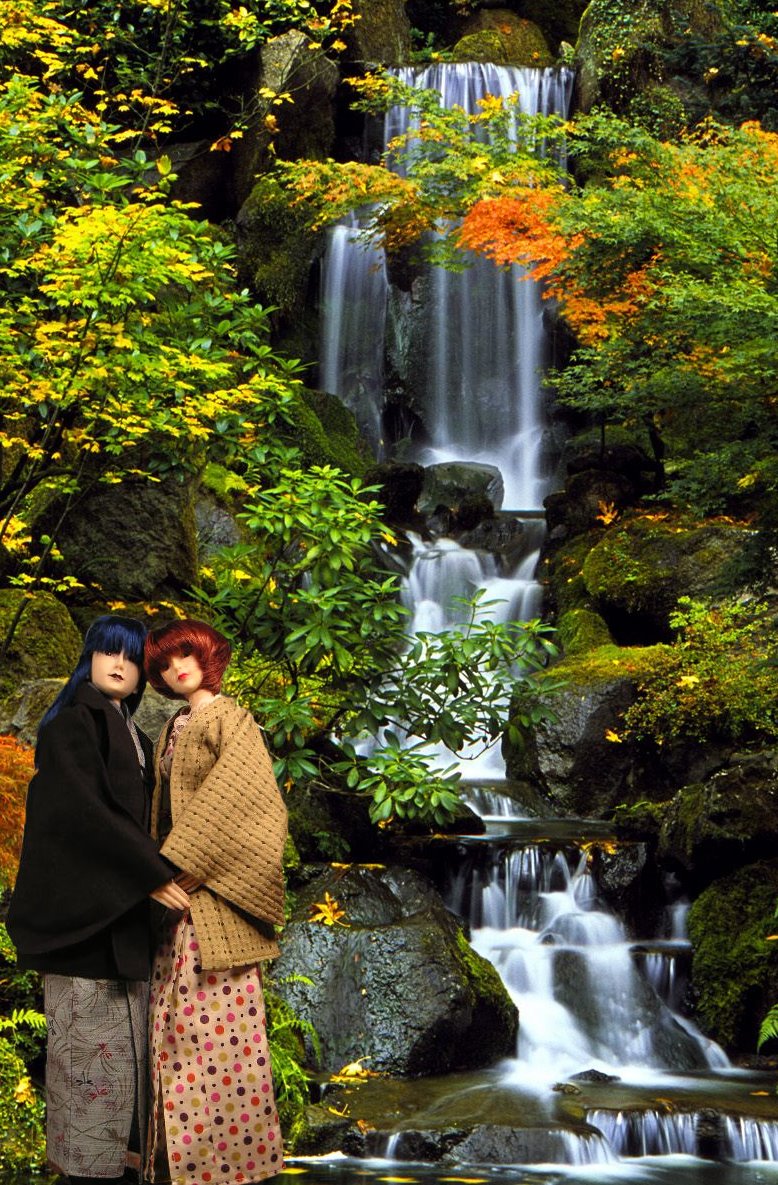
Snow and Akira Meet
Snow and Akira greet each other for the first time at Snow's home.

Snow invites Akira to join her as she performs the tea ceremony.

The Spiritual World of Tea
In the tea ceremony, water represents yin and fire in the hearth yang . The water is held in a jar called the mizusashi . This stoneware jar contains fresh water symbolizing purity, and is touched only by the host. Matcha is kept in a small ceramic container called a chaire which is in turn covered in a shifuku (fine silk pouch) which is set in front of the mizusashi. The occasion will dictate the type of tana (stand) used to display the chosen utensils.
If tea is served during the day a gong is sounded, in evening a bell. Usually struck or rung five to seven times, it summons the guests back to the tea house. They purify hands and mouth once and enter. They admire the flowers, kettle and hearth and seat themselves.
The host enters with the chawan (tea bowl)which holds the chasen (tea whisk), chakin (the tea cloth) which is a bleached white linen cloth used to dry the bowl, and the chashaku (tea scoop), a slender bamboo scoop used to dispense the matcha, which rests across it. These are arranged next to the water jar which represents the sun (symbolic of yang); the bowl is the moon (yin). Retiring to the preparation room, the host returns with the kensui (waste water bowl), the hishaku (bamboo water ladle) and futaoki (a green bamboo rest for the kettle lid). She then closes the door to the preparation room.
Using a fukusa (fine silk cloth), which represents the spirit of the host, the host purifies the tea container and scoop. Deep significance is found in the host's careful inspection, folding and handling of the fukusa, for her level of concentration and state of meditation are being intensified. Hot water is ladled into the tea bowl, the whisk is rinsed, the tea bowl is emptied and wiped with the chakin.
Lifting the tea scoop and tea container, the host places three scoops of tea per guest into the tea bowl. Hot water is ladled from the kettle into the teabowl in a quantity sufficient to create a thin paste with the whisk. Additional water is then added to so the paste can be whisked into a thick liquid consistent with pea soup. Unused water in the ladle is returned to the kettle.
The host passes the tea bowl to the main guest who bows in accepting it. The bowl is raised and rotate in the hand to be admired. The guest then drinks some of the tea, wipes the rim of the bowl, and passes the bowl to the next guest who does the same as the main guest.
When the guests have all tasted the tea the bowl is returned to the host who rinses it. The whisk is rinsed and the tea scoop and the tea container cleaned.
The scoop and tea container are offered to the guests for examination. A discussion of the objects, presentation and other appropriate topics takes place.
Preparing for Departure
The fire is then rebuilt for usa cha (thin tea). This tea will rinse the palate and symbolically prepares the guests for leaving the spiritual world of tea and re-entering the physical world. Smoking articles are offered, but rarely does smoking take place in a tearoom. This is but a sign for relaxation.
Zabuton (cushions) and teaburi (hand warmers) are offered. To compliment usa cha, higashi (dry sweets) are served. Usa cha and koi cha are made in the same manner, except that less tea powder of a lesser quality is used, and it is dispensed from a date-shaped wooden container called natsume. The tea bowl is more decorative in style; and guests are individually served a bowl of this frothy brew.
At the conclusion, the guests express their appreciation for the tea and admiration for the art of the host. They leave as the host watches from the door of the teahouse.
Akira expresses his appreciation to Snow and prepares to leave.

Snow watches from the door, but as Akira reaches the waterfall, she can contain herself no longer and rushes after him.
